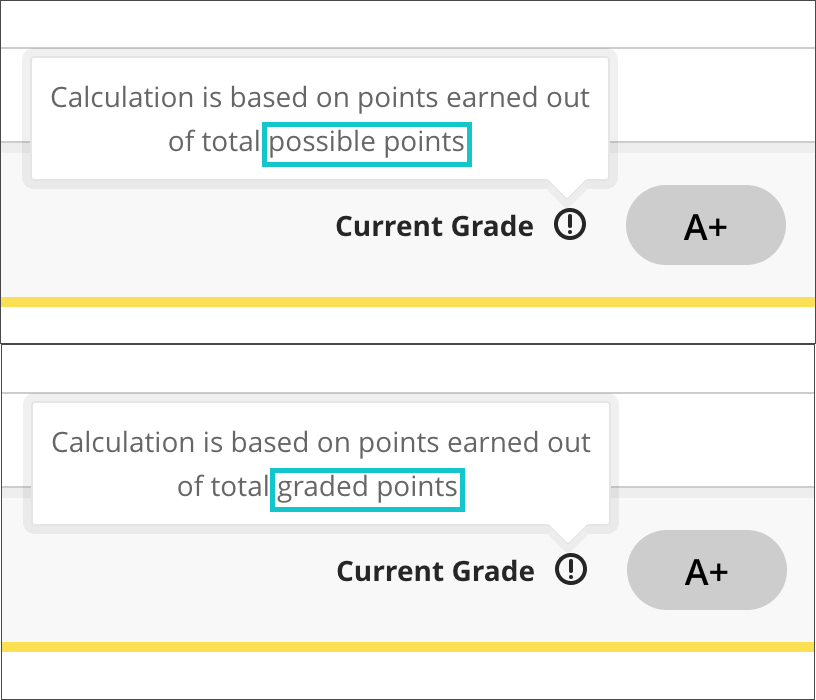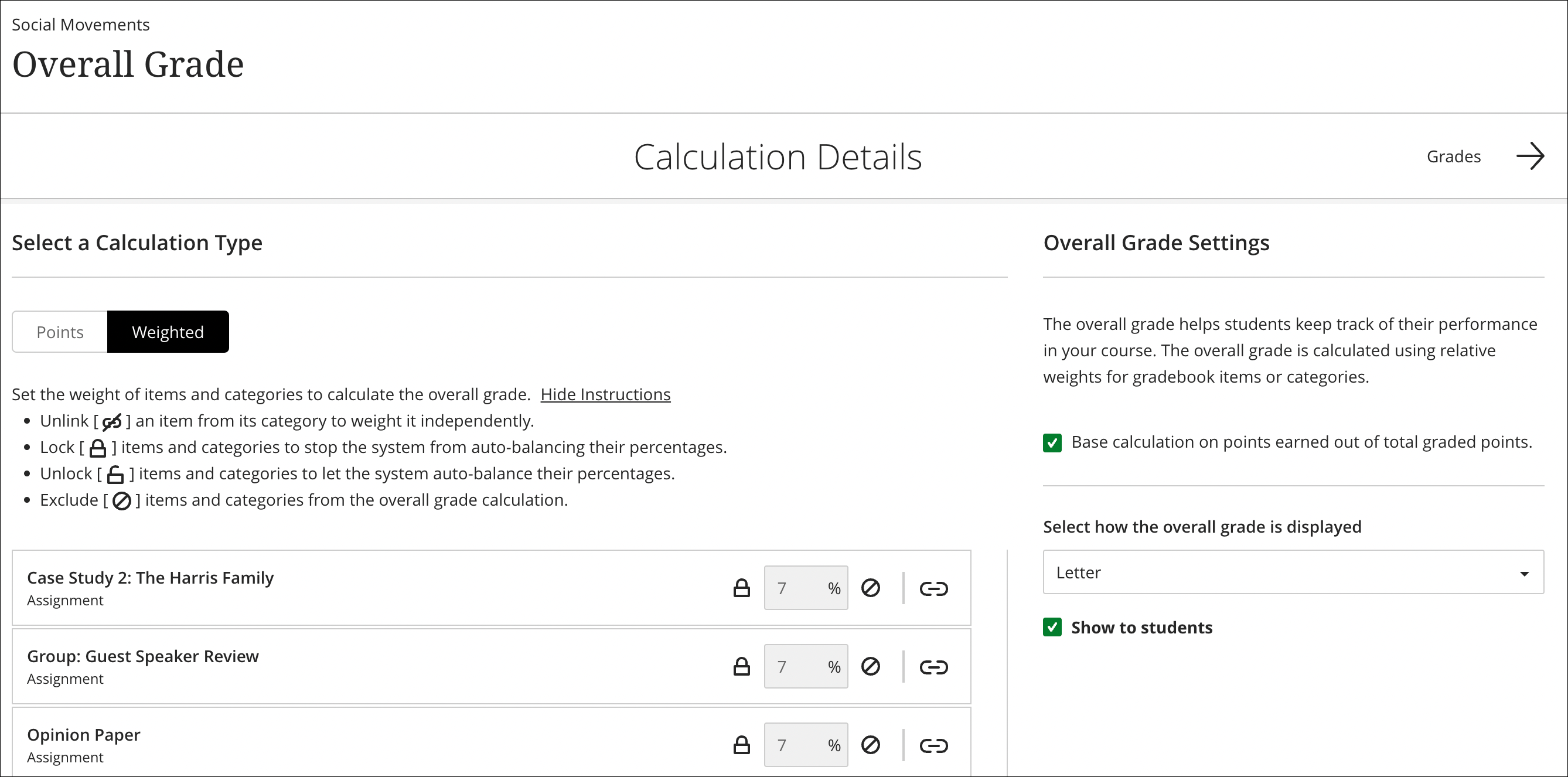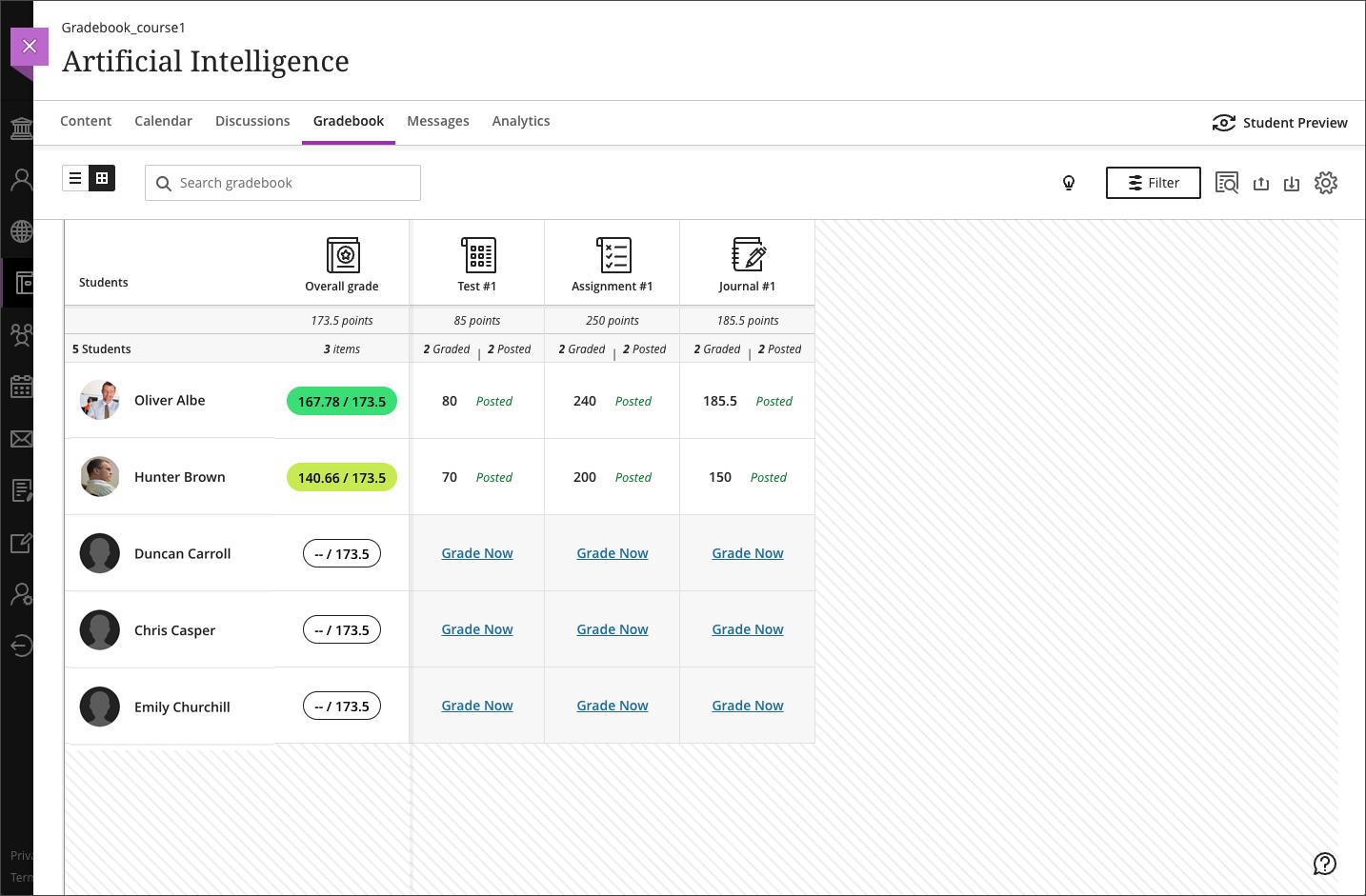Overall Grade Explanation
Watch the Managing the Gradebook Video to learn more about the setup and management of the Ultra Gradebook. The Overall Grade Column is specifically covered from 5:24 – 12:12.
The Overall Grade column must be set up in the Gradebook and is the points earned divided by total graded points available. On by default in all courses, this is a “running total” which means that grade columns not yet attempted are ignored when calculating the current overall grade for the course. This setting can be changed using the gear icon to access the “Manage Overall Grade Settings” and checking or unchecking the box next to "Base calculation on points earned out of total graded points." Before turning off Running Total, review the Importance of Automatic Zeros and Running Total: Accuracy in Academic Standing tutorial.
See Also:
Students can see the Overall Grade and calculation details from the information icon in their Gradebook. Dynamic text explains the instructor's calculation choice. The student may also select the Overall Grade pill to see calculation details.
Image: Student view of dynamic text to explain the Overall Grade calculation options

See:
From the List View of the Gradebook, on the Gradable Items tab or from Grid View of the Gradebook, click on the Settings gear icon, go to the Overall Grade section, click on Set Up (or Manage) Overall Grade.

To get started, choose between Points, Weighted, or Advanced for the Overall Grade Calculation. To learn more about these options see the related tutorial for each:

Once you've made your selection, you can begin to assign grade points, percentage weights, or use an advanced formula. If you use category weights to calculate the overall grade, you can expand a category to see the graded items included.

NOTE: To be included in the Overall Grade, graded activities must be in a category. See Create and Manage Gradebook Categories.
NOTE: In Blackboard Learn Ultra, potential minor differences may appear between the computation of the Overall Grade and the total derived from the Add Calculation function, due to each formula's mathematical definition of score weightage.
In some cases, this slight difference, as little as 0.01, may have a significant impact on the computation based on Ultra's grade scheme.
If all score items have the same maximum points, the grade for both calculations will be same as the weightage difference will cancel, and thus, the percentage assigned by the grade scheme will match.
To make items or categories exempt from the overall grade, select the Exempt icon Ø next to the point or overall grade percentage field. The item or category turns gray to indicate that it's not included in the calculation. Select the icon again to include the item or category in the calculation again.
Expand the category to see its items. From here you can:
- Unlink an item from its category. This is useful if you want to exclude an item from a category calculation rule.
- Exclude an item within a category from the overall grade calculation. This removes the item points from the total number of points available in the course
Choose how you want the Overall Grade to display in Overall Grade Settings. You can display a letter grade, percentage, or points. With the points display option, instructors and students see the overall grade as a fraction. For example, 745/800.


Select Save when you're finished. The Overall Grade column appears in the Gradebook next to the student's names so you can quickly see how each student is performing.
NOTE: Anonymously graded assessments aren't included in calculations until you turn off anonymity.
The student and instructor view of the overall grade changes as you create and grade course content included in the Overall Grade calculation.
An item's visibility doesn't affect the overall grade. However, students can only see posted grades, so a student's view of the Overall Grade only includes grades that you've posted. An instructor's view of the Overall Grade includes all grades, whether or not you've posted them. In some cases, you might see a different overall grade than your students see.
You can create and manage grade notations to override a student's Overall Grade if their performance falls outside the defined schema. For example, if a student has to withdraw from your course in the middle of a semester, you can use a grade notation to indicate the student's circumstance or situation without assigning an actual grade.
Creating a Gradebook Notation
From the Gradebook click on the Settings gear icon in the upper right corner to open the Gradebook Settings panel. In the Overall Grade Notations section click on Add Overall Grade Notation. In the Notation box, type in a 6-character code or word to identify the notation. In the Description box to the right, enter in a brief explanation as to what the notation is about. Close the Side Panel.

Applying a Gradebook Notation
To apply a grade notation to a student's overall grade, go to the Gradebook in Grid View and select within a student's overall grade cell. In the menu that appears, choose the Notation applicable to the student's circumstance. The cell will turn gray to indicate that you overrode the overall grade.
Image 1: adding a notation to student's overall grade cell. Image 2: Display of Notation Code after notation applied.


To remove the override, select the student's overall grade cell and select Undo Override. The overall grade reverts back to the overall grade calculation you defined for the course.